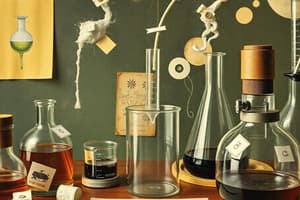Podcast
Questions and Answers
What is the primary purpose of a laboratory room?
What is the primary purpose of a laboratory room?
- To store chemicals safely for long-term use.
- To provide a place for relaxation and study.
- To conduct scientific research and experiments. (correct)
- To hold administrative meetings and discussions.
Which of the following is NOT a preventive measure to be taken inside a laboratory room?
Which of the following is NOT a preventive measure to be taken inside a laboratory room?
- Eating snacks during experiments (correct)
- Tying back long hair
- Wearing safety goggles
- Washing hands after handling chemicals
Which of the following correctly describes prokaryotic cells?
Which of the following correctly describes prokaryotic cells?
- They are complex cells with a membrane-bound nucleus.
- They are simple, single-celled organisms without organelles. (correct)
- They contain DNA within a membrane-enclosed nucleus.
- They lack a defined nucleus and are generally larger.
What is a recommended safety practice when working in a laboratory?
What is a recommended safety practice when working in a laboratory?
What safety equipment should one be aware of in a laboratory?
What safety equipment should one be aware of in a laboratory?
Which characteristic differentiates eukaryotic cells from prokaryotic cells?
Which characteristic differentiates eukaryotic cells from prokaryotic cells?
What should a lab worker do if a spill or accident occurs?
What should a lab worker do if a spill or accident occurs?
What type of signs are commonly used in laboratories to convey safety information?
What type of signs are commonly used in laboratories to convey safety information?
What is the primary distinction between prokaryotic and eukaryotic cells?
What is the primary distinction between prokaryotic and eukaryotic cells?
Which of the following statements about eukaryotic cells is correct?
Which of the following statements about eukaryotic cells is correct?
What type of organisms can be classified as eukaryotes?
What type of organisms can be classified as eukaryotes?
Which of the following is NOT a characteristic of prokaryotic cells?
Which of the following is NOT a characteristic of prokaryotic cells?
What structure do eukaryotic cells possess that distinguishes them from prokaryotic cells?
What structure do eukaryotic cells possess that distinguishes them from prokaryotic cells?
What is the size range commonly associated with eukaryotic cells?
What is the size range commonly associated with eukaryotic cells?
What component is found in the cell walls of fungi but NOT in bacteria?
What component is found in the cell walls of fungi but NOT in bacteria?
Which type of cell division is characteristic of eukaryotic cells?
Which type of cell division is characteristic of eukaryotic cells?
Flashcards
Laboratory Room
Laboratory Room
A controlled environment for scientific research and experiments.
Preventive Measures in Lab
Preventive Measures in Lab
Safety practices to follow in a laboratory to avoid accidents.
Wear Safety Goggles
Wear Safety Goggles
Protective eyewear to shield eyes from hazards like chemicals.
Wash Hands After Handling Chemicals
Wash Hands After Handling Chemicals
Signup and view all the flashcards
Prokaryotes
Prokaryotes
Signup and view all the flashcards
Eukaryotes
Eukaryotes
Signup and view all the flashcards
Lab Safety Signs
Lab Safety Signs
Signup and view all the flashcards
Microscopy
Microscopy
Signup and view all the flashcards
Mitochondria
Mitochondria
Signup and view all the flashcards
Endoplasmic Reticulum
Endoplasmic Reticulum
Signup and view all the flashcards
Golgi Apparatus
Golgi Apparatus
Signup and view all the flashcards
Prokaryotic Cells
Prokaryotic Cells
Signup and view all the flashcards
Eukaryotic Cells
Eukaryotic Cells
Signup and view all the flashcards
Bacteria
Bacteria
Signup and view all the flashcards
Cell Wall
Cell Wall
Signup and view all the flashcards
Microbiology
Microbiology
Signup and view all the flashcards
Study Notes
Laboratory Room
- A laboratory room is a controlled environment for scientific research, experiments, analysis, and measurements.
- It includes specialized tools, instruments, and safety equipment.
- Researchers, scientists, and technicians use the room to conduct experiments accurately and safely.
Laboratory Instruments
- Bunsen burner: A gas burner used for heating in laboratories.
- Evaporating dish: A shallow, often round, dish used for evaporating liquids.
- Bacterial loop: A tool used to transfer small amounts of bacteria or other biological samples.
- Wire brush: A tool used for cleaning lab equipment.
- Crucible and cover: A container for high-temperature processes, often used in chemistry.
- 24-well plate: A plate with multiple small wells, typically used for small-scale experiments or assays.
- Test-tube rack: A rack for holding test tubes.
- Mortar and pestle: Used for grinding substances into a fine powder.
- Lab burner: A gas burner used in experiments, typically with a variable flame height for controlling temperature.
- Forceps: Used for handling small samples or delicate objects.
- Wash bottle: A bottle with a nozzle for dispensing liquids, used to wash laboratory equipment.
- Pipet: A laboratory tool used to measure and transfer small volumes of liquid.
- Graduated cylinder: Used to measure liquid volumes accurately.
- Volumetric flask: Used to prepare specific volumes of solutions.
- Conical flask: Used for mixing, heating, and storing liquids.
- Watch glass: A shallow, circular glass used for covering beakers or evaporating substances.
- Funnel: Used for pouring liquids into containers with small openings.
- Dropper/pipette: Used to transfer small amounts of liquid.
- Petri dish: A shallow dish used to culture microorganisms.
Laboratory Safety Precautions
- Always follow instructions carefully.
- Wear appropriate safety equipment, like safety goggles.
- Notify your teacher if there are spills or accidents.
- Wash your hands after handling chemicals.
- Keep hands away from face during experiments.
- Tie back hair and roll up sleeves.
- Know the location of fire extinguishers, first aid kits, eyewash stations, and other safety equipment.
- Keep work areas clear of clutter.
- Do not eat or drink in the laboratory.
- Wear safety glasses or goggles when doing experiments.
- Ensure you know the location of fire extinguishers, eyewash fountains, and emergency exits.
Microbiology
-
Microbiology is the study of microscopic organisms.
-
It includes cells that are either unicellular (Bacteria), multicellular (fungi), or acellular (virus)
-
Prokaryotic cells: These are simple, single-celled organisms that lack a membrane-bound nucleus and have their genetic material (DNA) in a region called the nucleoid.
-
Eukaryotic cells: More complex; have a defined membrane-bound nucleus and membrane-bound organelles. Examples include mitochondria, the endoplasmic reticulum, and the Golgi apparatus.
-
Bacteria are single-celled organisms which can exist independently or as parasites.
-
Bacteria can be in different shapes, including coccus, coccobacillus, vibrio, bacillus, spirillum, and spirochete.
-
Bacteria can form various aggregations or structures.
Studying That Suits You
Use AI to generate personalized quizzes and flashcards to suit your learning preferences.




